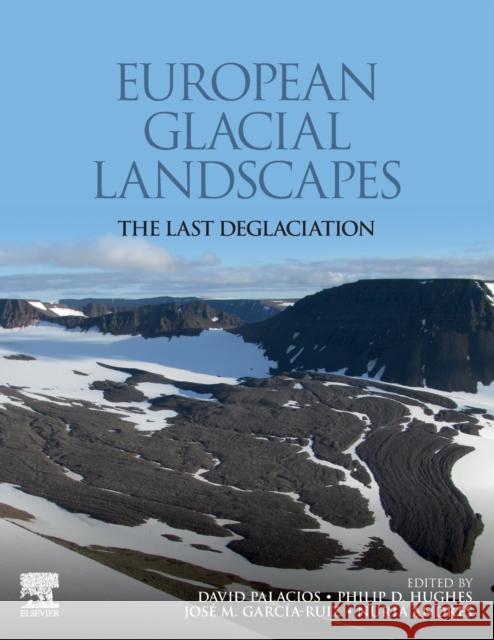European Glacial Landscapes: The Last Deglaciation » książka



European Glacial Landscapes: The Last Deglaciation
ISBN-13: 9780323918992 / Angielski / Miękka / 2022
European Glacial Landscapes: The Last Deglaciation
ISBN-13: 9780323918992 / Angielski / Miękka / 2022
(netto: 566,66 VAT: 5%)
Najniższa cena z 30 dni: 579,30 zł
ok. 8-10 dni roboczych
Dostawa przed świętami

Darmowa dostawa!
PART I. Introduction 1. Introduction 2. The Terminations of the Glacial Cycles. 3. Previous synthesis of Last Deglaciation in Europe
PART II. Climate changes during the Last Deglaciation in the Eastern North Atlantic region 4. Introduction 5. The Heinrich-1 Stadial 6. The Bølling-Allerød Interstadial 7. The Younger Dryas Stadial
PART III. The European glacial landforms during main deglaciation (18.9-14.6 ka) 8. Concept and global context of the glacial landforms from deglaciation SECTION 1. European regions that were covered by the European Ice Sheet Complex (EISC) 9. European Ice Sheet Complex evolution during main deglaciation (18.9-14.6 ka) 10. Fennoscandia: glacial landforms during deglaciation (18.9-14.6 ka) 11. Northern Central Europe: glacial landforms during deglaciation (18.9-14.6 ka) 12. European Russia: glacial landforms during deglaciation (18.9-14.6 ka) 13. The Eurasian Arctic: Glacial landforms during main deglaciation (18.9-14.6 ka) 14. The North Sea and Mid Norwegian Continental Margin: glacial landforms during deglaciation, the Bølling-Allerød Interstadial and the Younger Dryas. 15. Britain and Ireland: glacial landforms during deglaciation (18.9-14.6 ka). SECTION 2. European regions that were not covered by the EISC 16. The Polar Ural Mountains: Deglaciation history. 17. Iceland: glacial landforms during deglaciation (18.9-14.6 ka) 18. The evolution of glacial landforms in the Tatra Mountains during deglaciation (18.9-14.6 ka). 19. The Romanian Carpathians: glacial landforms during deglaciation (18.9-14.6 ka). 20. The Alps: glacial landforms during deglaciation (18.9 to 14.6 ka). 21. The Pyrenees: environments and landforms in the aftermath of the LGM (18.9-14.6 ka). 22. The evolution of glacial landforms in Iberian Mountains during deglaciation (18.9-14.6 ka). 23. The Italian Mountains: glacial landforms during deglaciation (18.9-14.6 ka). 24. The Balkans: glacial landforms during deglaciation (18.9-14.6 ka). 25. The Anatolian Mountains: glacial landforms during deglaciation (18.9-14.6 ka). SECTION 3. Synthesis of Part III 26. The European glacial landscapes from the main deglaciation
PART IV. The European glacial landforms from the Bølling-Allerød Interstadial (14.6-12.9 ka) 27. Concept and global context of the glacial landforms from the Bølling-Allerød Interstadial SECTION 1. European regions that were covered by the European Ice Sheet Complex (EISC) 28. European Ice Sheet Complex evolution during the Bølling-Allerød Interstadial (14.6-12.9 ka) 29. Fennoscandia: glacial landforms from the Bølling-Allerød Interstadial (14.6-12.9 ka). 30. Northern Central Europe: glacial landforms from the Bølling-Allerød Interstadial 31. European Russia: glacial landforms from the Bølling-Allerød Interstadial 32. The Eurasian Arctic: Glacial landforms from the Bølling-Allerød Interstadial (14.6-12.9 ka BP). 33. Britain and Ireland: glacial landforms from the Bølling-Allerød Interstadial. SECTION 2: European regions that were not covered by the EISC 34. Iceland: Glacial landforms and raised shorelines from the Bølling-Allerød interstadial. 35. The evolution of glacial landforms in the Tatra Mountains during the Bølling-Allerød Interstadial. 36. The Romanian Carpathians: glacial landforms during Bølling -Allerød Interstadial. 37. The Alps: glacial landforms from the Bølling-Allerød Interstadial 38. The Pyrenees: glacial landforms from the Bølling-Allerød Interstadial 39. The evolution of glacial landforms in the Iberian Mountains during Bølling-Allerød Interstadial. 40. The Italian Mountains: glacial landforms from the Bølling-Allerød Interstadial 41. The Balkans: glacial landforms from the Bølling-Allerød Interstadial 42. The Anatolian Mountains: glacial landforms from the Bølling-Allerød Interstadial SECTION 3. Synthesis of the Part IV 43. European glacial landscapes from the Bølling-Allerød Interstadial
PART V. The European glacial landforms from the Younger Dryas Stadial (12.9-11.7 ka) 44. Concept and global context of the glacial landforms from Younger Dryas SECTION 1. European regions that were covered by the European Ice Sheet Complex (EISC) 45. The EISC evolution during the Younger Dryas Stadial (12.9-11.7 ka). 46. The Fennoscandian Ice Sheet during the Younger Dryas Stadial. 47. Younger Dryas local moraines in western and northern Norway 48. Northern Central Europe: glacial landforms from the Younger Dryas Stadial. 49. European Russia: glacial landforms from the Younger Dryas Stadial. 50. The Eurasian Arctic:?Glacial landforms from the Younger Dryas Stadial. 51. Britain and Ireland: glacial landforms from the Younger Dryas Stadial SECTION 2. European regions that not were covered by the EISC 52. Iceland: glacial landforms from the Younger Dryas Stadial 53. The evolution of glacial landforms in the Tatra Mountains during the Younger Dryas Stadial. 54. The Romanian Carpathians: glacial landforms from the Younger Dryas 55. The Alps: glacial landforms from the Younger Dryas Stadial 56. The Pyrenees: glacial landforms from the Younger Dryas Stadial 57. The evolution of glacial landforms in Iberian Mountains during the Younger Dryas Stadial. 58. The Italian Mountains: glacial landforms from the Younger Dryas Stadial. 59. The Balkans: glacial landforms from the Younger Dryas Stadial. 60. The Anatolian Mountains: glacial landforms from the Younger Dryas Stadial. SECTION 3. Synthesis of Part V 61. The European glacial landscapes from the Younger Dryas Stadial
PART VI. The Synthesis of the European Landscapes from Last Deglaciation 62. The importance of European glacial landscapes in a context of great climatic variability
1997-2024 DolnySlask.com Agencja Internetowa
KrainaKsiazek.PL - Księgarnia Internetowa









